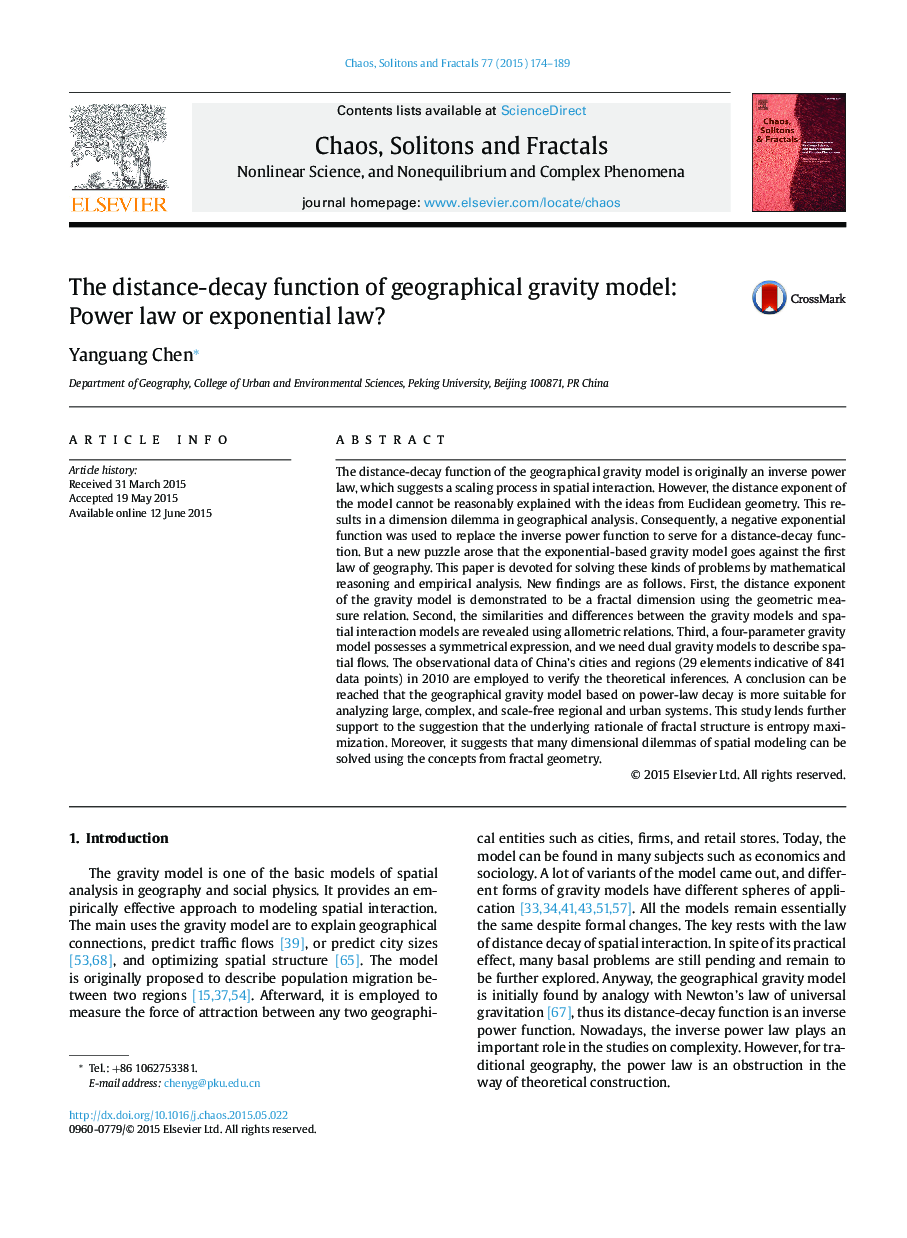| کد مقاله | کد نشریه | سال انتشار | مقاله انگلیسی | نسخه تمام متن |
|---|---|---|---|---|
| 8254846 | 1533647 | 2015 | 16 صفحه PDF | دانلود رایگان |
عنوان انگلیسی مقاله ISI
The distance-decay function of geographical gravity model: Power law or exponential law?
ترجمه فارسی عنوان
تابع فشرده سازی فاصله از مدل جغرافیایی جغرافیایی: قانون قدرت یا قانون نمایشی؟
دانلود مقاله + سفارش ترجمه
دانلود مقاله ISI انگلیسی
رایگان برای ایرانیان
ترجمه چکیده
تابع فشرده سازی فاصله از مدل جاذبه جغرافیایی در اصل یک قانون قدرت معکوس است که نشان می دهد فرآیند پوسته پوسته شدن در تعامل فضایی است. با این حال، شاخص فاصله از مدل نمی تواند منطقی با ایده های هندسی اقلیدسی توضیح داده شود. این در معرض یک معضل ابعادی در تحلیل جغرافیایی است. در نتیجه، یک تابع نماینده منفی برای جایگزینی تابع قدرت معکوس برای خدمت به تابع فشرده سازی فاصله استفاده شد. اما یک پازل جدید بوجود آمد که مدل گرانشی مبتنی بر نماد بر علیه قانون اول جغرافیا پیش می رود. این مقاله برای حل این نوع مشکلات با استدلال ریاضی و تحلیل تجربی اختصاص داده شده است. یافته های جدید به شرح زیر است. اول، شاخص فاصله از مدل جاذبه به عنوان ابعاد فراکتال با استفاده از رابطه اندازه گیری هندسی نشان داده شده است. دوم، شباهت ها و تفاوت های بین مدل های گرانش و مدل های تعامل فضایی با استفاده از روابط آلومتریک نشان داده شده است. سوم، یک مدل گرانش چهار پارامتر دارای بیان متقارن است و ما برای مدل سازی جریان های فضایی نیاز به مدل های دوگانه گرانش داریم. داده های مشاهداتی از شهرستانها و مناطق چین (29 عنصر از 841 نقطه داده) در سال 2010 برای بررسی استنباط های نظری استفاده شده است. نتیجه گیری می تواند به دست آید که مدل گرانش جغرافیایی بر اساس شکست قدرت قانون مناسب تر است برای تحلیل سیستم های منطقه ای و شهری بزرگ، پیچیده و بدون مقیاس. این مطالعه پشتیبانی بیشتری را به پیشنهاد می دهد که منطق اساسی ساختار فراکتال حداکثر شدن آنتروپی است. علاوه بر این، آن را نشان می دهد که بسیاری از معضلات بعدی مدل سازی فضایی را می توان با استفاده از مفاهیم هندسه فراکتال حل کرد.
موضوعات مرتبط
مهندسی و علوم پایه
فیزیک و نجوم
فیزیک آماری و غیرخطی
چکیده انگلیسی
The distance-decay function of the geographical gravity model is originally an inverse power law, which suggests a scaling process in spatial interaction. However, the distance exponent of the model cannot be reasonably explained with the ideas from Euclidean geometry. This results in a dimension dilemma in geographical analysis. Consequently, a negative exponential function was used to replace the inverse power function to serve for a distance-decay function. But a new puzzle arose that the exponential-based gravity model goes against the first law of geography. This paper is devoted for solving these kinds of problems by mathematical reasoning and empirical analysis. New findings are as follows. First, the distance exponent of the gravity model is demonstrated to be a fractal dimension using the geometric measure relation. Second, the similarities and differences between the gravity models and spatial interaction models are revealed using allometric relations. Third, a four-parameter gravity model possesses a symmetrical expression, and we need dual gravity models to describe spatial flows. The observational data of China's cities and regions (29 elements indicative of 841 data points) in 2010 are employed to verify the theoretical inferences. A conclusion can be reached that the geographical gravity model based on power-law decay is more suitable for analyzing large, complex, and scale-free regional and urban systems. This study lends further support to the suggestion that the underlying rationale of fractal structure is entropy maximization. Moreover, it suggests that many dimensional dilemmas of spatial modeling can be solved using the concepts from fractal geometry.
ناشر
Database: Elsevier - ScienceDirect (ساینس دایرکت)
Journal: Chaos, Solitons & Fractals - Volume 77, August 2015, Pages 174-189
Journal: Chaos, Solitons & Fractals - Volume 77, August 2015, Pages 174-189
نویسندگان
Yanguang Chen,
